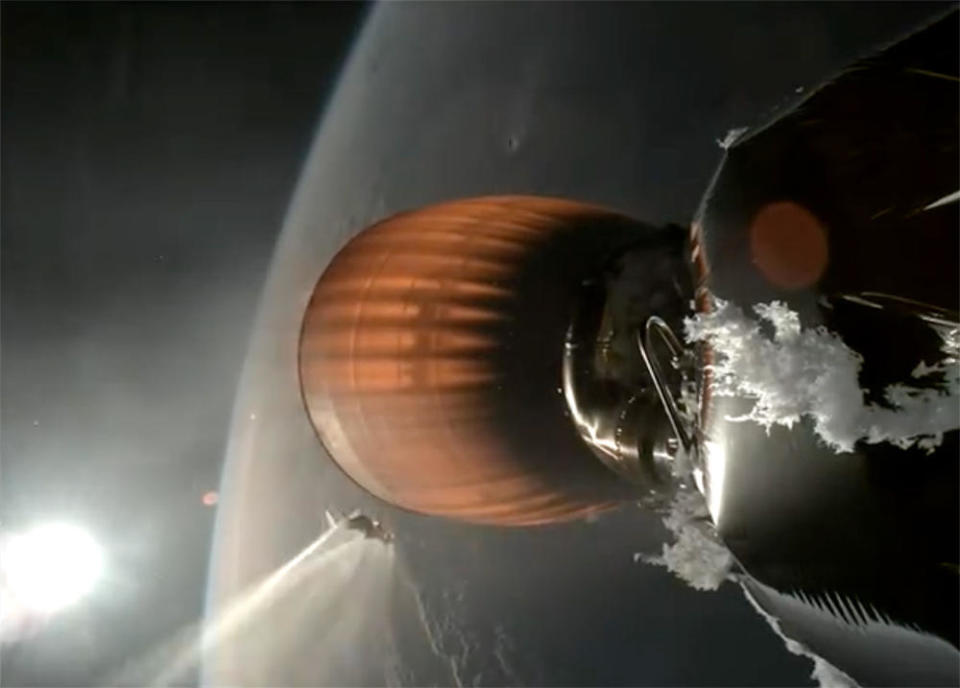The SpaceX rocket upper stage engine failure Twenty Starlink internet satellites are stuck in a low, unviable orbit, the Federal Aviation Administration said late Thursday, a situation that will be investigated and will delay at least one and possibly two piloted flights of the company’s Falcon 9 rockets in the coming days.
The accident ended a remarkable streak of 344 consecutive successful Falcon 9 flights since 2015. The FAA, which licenses commercial launch operations in the United States, said Friday that a joint malfunction investigation is required before the workforce’s Falcon 9 is allowed to fly again.

“A return to flight is contingent upon the FAA determining that any system, process or procedure related to the accident does not impact public safety,” the FAA said. “Additionally, SpaceX may be required to request and receive approval from the FAA to amend its license, which includes corrective actions and meets all other licensing requirements.”
Meanwhile, the Polaris Dawn spacecraft, scheduled to launch July 31 for entrepreneur Jared Isaacman and his three crewmates on a commercial flight that would include the first spacewalk by private citizens, has been thrust into limbo.
The failure could also impact NASA’s plans to launch its next long-duration crewed mission to the International Space Station. The Crew 9 mission is currently targeted for liftoff around Aug. 19, but that assumes the SpaceX failure investigation is complete by then and NASA agrees with the findings.
Isaacman, however, did not give up and shared a note on social media stating that he and his crew, which included two SpaceX employees, had full confidence in the Falcon 9.
“SpaceX has an incredible history with the Falcon 9,” he said. “From personal experience, I can say that when issues arise, they are very transparent. I have no doubt that they will quickly find a cause and ensure that the most cost-effective and reliable launch vehicle continues to deliver the payload to orbit.
“As for Polaris Dawn, we will fly it when SpaceX is ready and we have full confidence in the rocket, the spacecraft and operations.”
Given SpaceX’s high flight speed and ability to launch its own payloads — Starlinks — the company could recover fairly quickly, but that will depend on what went wrong, what might be needed to fix it, and whether the FAA issues a new launch license.
SpaceX founder Elon Musk thanked Isaacman for his support, saying the company would “investigate the issue and look for other possible accidents.” “We aim to make more Falcon flights this year than the shuttle has made in 30 years, and the vast majority of them will be uncrewed.”
“One of the big advantages of this super-high flight speed is that we can detect and fix problems that might occur once every 1,000 flights. This is impossible in a low-speed vehicle.”
Regardless of how it unfolds, the incident is a testament to NASA’s ongoing efforts to certify Boeing’s Starliner capsule. ongoing test flight The space agency wants two crew ferry ships from different suppliers to ensure the International Space Station remains full of NASA astronauts in case a malfunction grounds one or the other.
Boeing has had its own problems with Starliner, including a series of software and hardware issues that delayed the launch by four years. The spacecraft is currently docked at the space station, but its return to Earth from its first piloted test flight is on hold pending additional analysis of helium leaks and problems with its thrusters.
Before Thursday’s launch, SpaceX had experienced only one in-flight failure in 354 launches of its Falcon 9 and Falcon Heavy rockets since their first flight in 2010.
A Falcon 9 carrying a Dragon cargo ship full of supplies and equipment destined for the International Space Station exploded during launch In June 2015, high-pressure helium ruptured the second stage’s liquid oxygen tank when one of the internal supports failed.
Musk said in a post on social media early Friday that the Starlink launch error occurred during an attempt to restart the rocket’s second-stage Merlin engine to place the vehicle in the proper Starlink delivery orbit.
Initially, he said the failure resulted in an “engine RUD,” a humorous acronym that stands for “rapid unplanned disassembly,” meaning the stage either exploded or at least suffered some sort of structural failure.
However, the company later said the failure was caused by a liquid oxygen fuel leak and that the stage survived the aborted engine ignition. However, while it did manage to deploy the Starlinks, they were left in an elliptical orbit with a low point well below a manageable altitude.
“Following a planned reburn of the upper stage engine to raise perigee (the lowest point in orbit), the Merlin Vacuum engine experienced an anomaly and was unable to complete its second burn,” SpaceX said in a statement on its website.
“Although the stage survived and deployed the satellites, it was unable to successfully circularize its orbit. This left the satellites in an eccentric orbit with a very low perigee of 135 kilometers (84 miles), which is less than half the expected perigee altitude.”
At this altitude, satellites are pulled down during repeated passes through the extreme upper atmosphere. Even at full power, the thrust from the onboard ion thrusters is “unlikely to be sufficient to successfully lift the satellites,” the company said.
“Therefore, the satellites will re-enter the Earth’s atmosphere and completely disappear (burn up). They pose no threat to other satellites in orbit or to public safety.”
President Biden holds solo press conference after NATO summit | Special Report
SpaceX Falcon 9 breaks apart after launch and other major news
Biden seeks to rally support in Detroit amid growing calls for his resignation